Relics at Parkminster
Next to the library at Parkminster is the relic chapel. Above the altar is a fine statue of the Sacred Heart - the photo does not do it justice. Devotion to the Sacred Heart is important in the history of the Carthusians because the heresy of Jansenism provided a subtle trap for those who are dedicated to contemplation in solitude and silence.
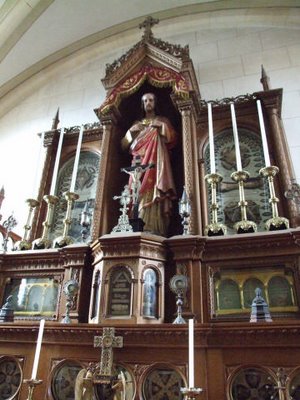 The chapel is filled with display cases containing hundreds of relics.
The chapel is filled with display cases containing hundreds of relics.
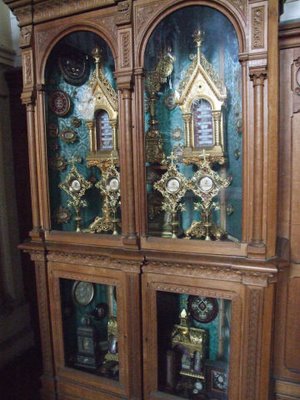 The most important is under the altar, the body of St Boniface (notice the skeleton underneath the reclining statue.)
The most important is under the altar, the body of St Boniface (notice the skeleton underneath the reclining statue.)
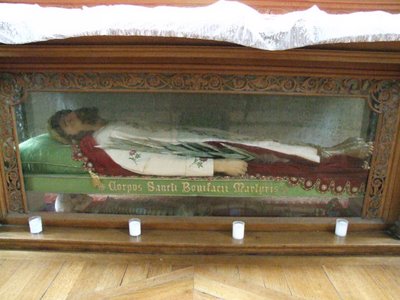 I rolled up the lace trim of the altar cloth to get a good photograph. But the lace itself is worth looking at in its own right. It is a very delicate lace - perhaps someone who is an expert can comment on it.
I rolled up the lace trim of the altar cloth to get a good photograph. But the lace itself is worth looking at in its own right. It is a very delicate lace - perhaps someone who is an expert can comment on it.
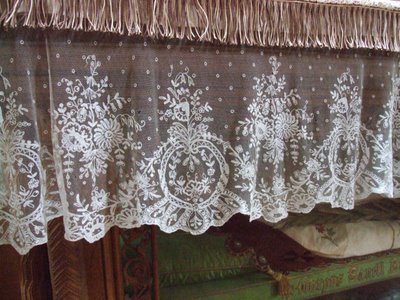 One one wall is an Agnus Dei. This is a wax tablet with the Lamb of God impressed on the front. On the reverse is an inscription recording the papal blessing. These devotional objects were very popular with Catholics in England at the time of the Reformation. Possession of an Agnus Dei was used as evidence that the holder was an obstinate papist.
One one wall is an Agnus Dei. This is a wax tablet with the Lamb of God impressed on the front. On the reverse is an inscription recording the papal blessing. These devotional objects were very popular with Catholics in England at the time of the Reformation. Possession of an Agnus Dei was used as evidence that the holder was an obstinate papist.
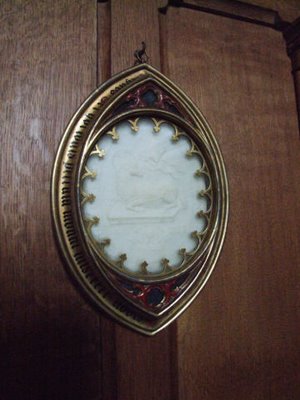 One of the more gruesome displays is the reliquary of St Victoriana:
One of the more gruesome displays is the reliquary of St Victoriana:
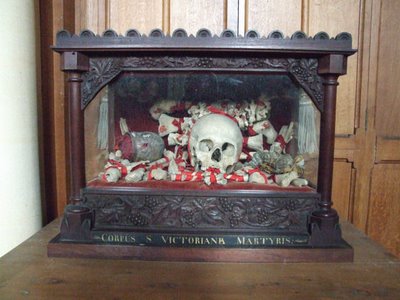 On the back wall of the chapel is a prized second class relic: the stole of St Hugh of Lincoln.
On the back wall of the chapel is a prized second class relic: the stole of St Hugh of Lincoln.
 St Hugh was a Frenchman, born at Avalon castle in Burgundy. He became a Carthusian at the Grande Chartreuse in 1160 and was the prior of the first English Carthusian monastery, founded at Witham by King Henry II in 1175 as a penance for the murder of St Thomas Becket. It is sad to reflect that by the time of the dissolution of the monasteries under King Henry VIII, there were twelve Carthusian houses in England. St Thomas More had at one time considered joining them.
St Hugh was a Frenchman, born at Avalon castle in Burgundy. He became a Carthusian at the Grande Chartreuse in 1160 and was the prior of the first English Carthusian monastery, founded at Witham by King Henry II in 1175 as a penance for the murder of St Thomas Becket. It is sad to reflect that by the time of the dissolution of the monasteries under King Henry VIII, there were twelve Carthusian houses in England. St Thomas More had at one time considered joining them.
 The chapel is filled with display cases containing hundreds of relics.
The chapel is filled with display cases containing hundreds of relics. The most important is under the altar, the body of St Boniface (notice the skeleton underneath the reclining statue.)
The most important is under the altar, the body of St Boniface (notice the skeleton underneath the reclining statue.) I rolled up the lace trim of the altar cloth to get a good photograph. But the lace itself is worth looking at in its own right. It is a very delicate lace - perhaps someone who is an expert can comment on it.
I rolled up the lace trim of the altar cloth to get a good photograph. But the lace itself is worth looking at in its own right. It is a very delicate lace - perhaps someone who is an expert can comment on it. One one wall is an Agnus Dei. This is a wax tablet with the Lamb of God impressed on the front. On the reverse is an inscription recording the papal blessing. These devotional objects were very popular with Catholics in England at the time of the Reformation. Possession of an Agnus Dei was used as evidence that the holder was an obstinate papist.
One one wall is an Agnus Dei. This is a wax tablet with the Lamb of God impressed on the front. On the reverse is an inscription recording the papal blessing. These devotional objects were very popular with Catholics in England at the time of the Reformation. Possession of an Agnus Dei was used as evidence that the holder was an obstinate papist. One of the more gruesome displays is the reliquary of St Victoriana:
One of the more gruesome displays is the reliquary of St Victoriana: On the back wall of the chapel is a prized second class relic: the stole of St Hugh of Lincoln.
On the back wall of the chapel is a prized second class relic: the stole of St Hugh of Lincoln. St Hugh was a Frenchman, born at Avalon castle in Burgundy. He became a Carthusian at the Grande Chartreuse in 1160 and was the prior of the first English Carthusian monastery, founded at Witham by King Henry II in 1175 as a penance for the murder of St Thomas Becket. It is sad to reflect that by the time of the dissolution of the monasteries under King Henry VIII, there were twelve Carthusian houses in England. St Thomas More had at one time considered joining them.
St Hugh was a Frenchman, born at Avalon castle in Burgundy. He became a Carthusian at the Grande Chartreuse in 1160 and was the prior of the first English Carthusian monastery, founded at Witham by King Henry II in 1175 as a penance for the murder of St Thomas Becket. It is sad to reflect that by the time of the dissolution of the monasteries under King Henry VIII, there were twelve Carthusian houses in England. St Thomas More had at one time considered joining them.